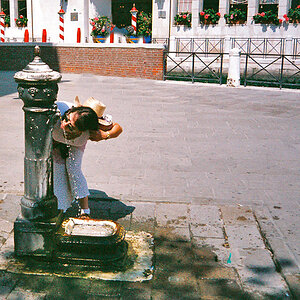d40bby
TPF Noob!
- Joined
- Apr 12, 2009
- Messages
- 41
- Reaction score
- 0
- Location
- Winston-Salem, NC
- Can others edit my Photos
- Photos OK to edit
I recently took some waterfall shots for the first time when I was out hiking. I experimented with shutter speeds etc, just trying to get the different effects you can get with the moving water.
When I got home and reviewed the shots, I noticed that there was a lot of glare coming from random places (it was a little sunny out) that I felt distracted from the shots.
I've been reading "understanding exposure" (a great recommendation from this forum :thumbup and Peterson mentions using a polarizing filter in situations like this.
and Peterson mentions using a polarizing filter in situations like this.
Well, I went to the store to grab a polarizer, and after telling the girl why I wanted it, she said "That's not what you want, you want a neutral density filter." She said it would help smooth out the waterfall shots. The packaging for the filter even had a side by side comparison shot of waterfalls. (it was a sunpak platinum plus filter).
Long story short, I bought both of them, but I was wondering which one is REALLY the one I want to use. I guess I'm just having trouble understanding the true difference between the two.
Which filter do you guys use for waterfall shots and why? I appreciate the input!
When I got home and reviewed the shots, I noticed that there was a lot of glare coming from random places (it was a little sunny out) that I felt distracted from the shots.
I've been reading "understanding exposure" (a great recommendation from this forum :thumbup
Well, I went to the store to grab a polarizer, and after telling the girl why I wanted it, she said "That's not what you want, you want a neutral density filter." She said it would help smooth out the waterfall shots. The packaging for the filter even had a side by side comparison shot of waterfalls. (it was a sunpak platinum plus filter).
Long story short, I bought both of them, but I was wondering which one is REALLY the one I want to use. I guess I'm just having trouble understanding the true difference between the two.
Which filter do you guys use for waterfall shots and why? I appreciate the input!




![[No title]](/data/xfmg/thumbnail/34/34070-2a43e701f983f62ada1c66a54d00be4e.jpg?1619736266)
![[No title]](/data/xfmg/thumbnail/34/34073-71bff52a53b8313ff2bcccab6b05f9b8.jpg?1619736266)





![[No title]](/data/xfmg/thumbnail/34/34072-be456691237ae73cb2936416e2e9e8c0.jpg?1619736266)
![[No title]](/data/xfmg/thumbnail/37/37137-43b5701b1efb7322c2c9fa6a1e30ccfa.jpg?1619737884)
